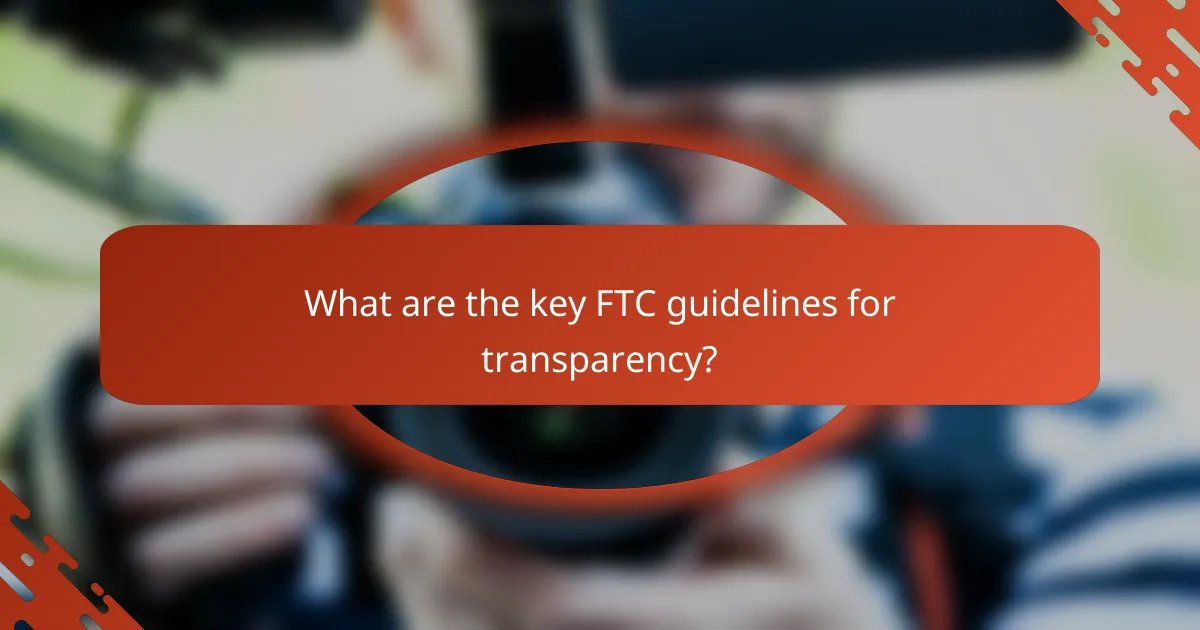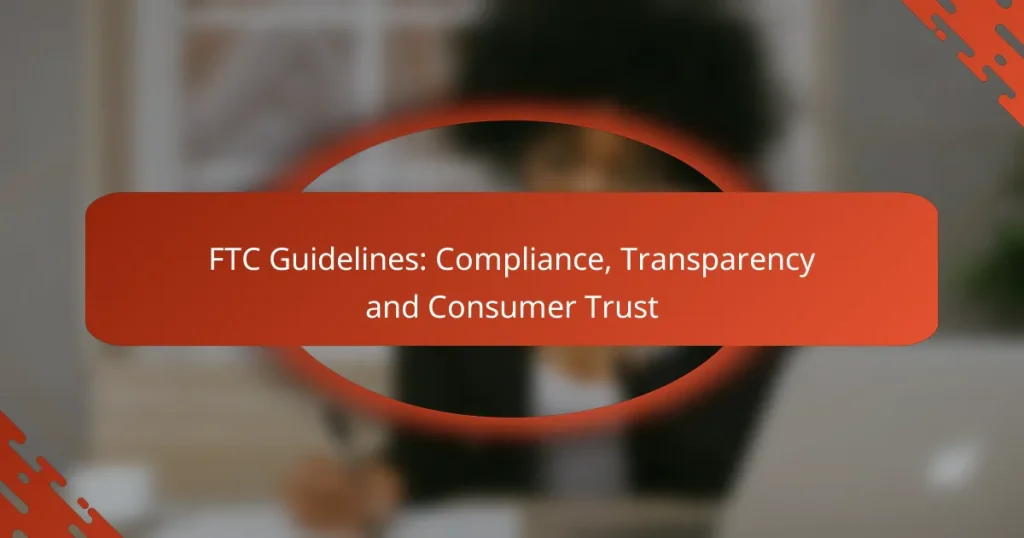The Federal Trade Commission (FTC) guidelines are crucial for ensuring compliance in affiliate marketing by promoting transparency and honesty in advertising. By implementing clear disclosures and maintaining transparent practices, businesses can build consumer trust and foster long-term relationships with their customers. Adhering to these guidelines not only enhances credibility but also encourages fair advertising practices that benefit both consumers and marketers.

How to ensure FTC compliance in affiliate marketing?
To ensure FTC compliance in affiliate marketing, it’s essential to follow specific guidelines that promote transparency and honesty in advertising. This involves clear disclosures, transparent practices, and regular reviews of affiliate agreements to maintain consumer trust.
Follow clear disclosure guidelines
Clear disclosure guidelines require that affiliate marketers openly communicate their relationships with brands. This means using straightforward language to inform consumers when they receive compensation for promoting products or services.
For example, phrases like “I may earn a commission if you purchase through my link” should be placed near the affiliate link. The FTC recommends that disclosures be made in a way that is hard to miss, such as at the beginning of a post or video.
Implement transparent advertising practices
Transparent advertising practices involve being honest about the nature of the products being promoted. Affiliates should avoid misleading claims and ensure that any endorsements reflect their genuine opinions.
Using real testimonials or personal experiences can enhance credibility. Additionally, it’s crucial to avoid exaggerating the benefits of products, as this can lead to distrust and potential legal issues.
Regularly review affiliate agreements
Regularly reviewing affiliate agreements helps ensure compliance with FTC guidelines and protects both the affiliate and the brand. This includes checking for any changes in terms that may affect disclosure requirements or advertising practices.
Affiliates should also stay informed about updates to FTC regulations and adjust their agreements accordingly. Keeping communication open with affiliate partners can help clarify expectations and maintain compliance.

What are the key FTC guidelines for transparency?
The key FTC guidelines for transparency focus on ensuring that consumers receive clear and honest information about products and services. These guidelines help build consumer trust by promoting fair advertising practices and requiring disclosures that inform potential buyers about material connections and the nature of the products being marketed.
Disclosure of material connections
Disclosure of material connections requires businesses to inform consumers about any relationships that could influence their purchasing decisions. For instance, if a social media influencer is paid to promote a product, they must clearly disclose this relationship to their audience. This transparency helps consumers understand potential biases in endorsements.
To comply, businesses should use clear language and prominent placement for disclosures, such as stating “paid partnership” or “sponsored content.” Avoid vague terms that may confuse consumers, and ensure that disclosures are easily visible, especially in digital formats.
Truthful representation of products
Truthful representation of products mandates that all claims made in advertising must be accurate and not misleading. This includes providing truthful information about a product’s features, benefits, and performance. For example, if a product claims to be “100% natural,” it must meet that standard without misleading consumers.
Businesses should substantiate their claims with reliable evidence, such as scientific studies or expert testimonials. Misleading representations can lead to legal consequences and damage to brand reputation, so it’s crucial to ensure that all marketing materials are factually correct.
Prohibition of deceptive practices
The prohibition of deceptive practices prevents businesses from engaging in advertising that misleads consumers, whether through false statements or omissions of critical information. This includes practices like bait-and-switch tactics or hidden fees that consumers are not made aware of until after a purchase.
To avoid deceptive practices, companies should conduct regular audits of their marketing strategies and ensure that all promotional materials are transparent. Training staff on ethical advertising standards can also help maintain compliance with FTC guidelines and foster consumer trust.

How to build consumer trust through compliance?
Building consumer trust through compliance involves adhering to regulations while maintaining transparency in business practices. This fosters a reliable relationship with customers, encouraging loyalty and repeat business.
Maintain consistent communication
Consistent communication is vital for establishing trust. Regular updates about product changes, policy adjustments, or company news keep consumers informed and engaged.
Utilize multiple channels such as email newsletters, social media, and website updates to reach your audience effectively. Aim for a frequency that keeps customers informed without overwhelming them, such as bi-weekly or monthly updates.
Provide clear return policies
Clear return policies enhance consumer confidence by outlining the steps for returns and exchanges. A straightforward policy should specify time frames, conditions for returns, and any associated costs.
Consider offering a 30-day return window with free returns to encourage purchases. Make this information easily accessible on your website, ideally on product pages and during the checkout process.
Engage with customer feedback
Engaging with customer feedback demonstrates that you value their opinions and are committed to improving your offerings. Actively seek feedback through surveys, reviews, and direct communication.
Respond to both positive and negative feedback promptly, showing appreciation for compliments and addressing concerns constructively. This interaction can significantly enhance trust and show that you are responsive to customer needs.

What are the consequences of non-compliance?
Non-compliance with FTC guidelines can lead to serious repercussions, including legal penalties, diminished consumer trust, and harm to brand reputation. Businesses must understand these consequences to maintain compliance and protect their interests.
Potential legal penalties
Companies that fail to comply with FTC guidelines may face significant legal penalties, including fines that can range from thousands to millions of dollars, depending on the severity of the violation. The FTC can initiate investigations and impose sanctions that disrupt business operations.
In addition to financial penalties, non-compliance can lead to mandatory compliance programs, which require businesses to implement costly changes to their practices. These legal repercussions can strain resources and divert attention from core business activities.
Loss of consumer trust
Non-compliance can severely erode consumer trust, as customers expect transparency and honesty from businesses. When companies are found to be misleading or deceptive, consumers may choose to take their business elsewhere, leading to a decline in sales.
Restoring consumer trust can be a lengthy and challenging process. Businesses may need to invest in public relations campaigns and improve their communication strategies to regain credibility and reassure customers of their commitment to ethical practices.
Negative impact on brand reputation
A brand’s reputation can suffer significantly due to non-compliance with FTC guidelines. Negative publicity from violations can spread quickly through social media and news outlets, damaging the brand’s image and leading to long-term consequences.
To mitigate this risk, businesses should proactively engage in compliance training and establish clear policies that promote ethical behavior. Regular audits and transparency in operations can help maintain a positive brand reputation and foster consumer loyalty.

How to create a compliance checklist for affiliates?
Creating a compliance checklist for affiliates involves identifying key regulations and establishing a system to ensure adherence. This checklist should cover essential areas such as advertising standards, disclosure requirements, and data protection laws.
Identify key compliance areas
Start by pinpointing the primary compliance areas relevant to your affiliate program. This typically includes FTC guidelines on endorsements and testimonials, which mandate clear disclosures when affiliates promote products. Additionally, consider privacy laws such as GDPR or CCPA that govern data handling practices.
Review industry-specific regulations that may apply, such as those related to financial services or health products. Keeping abreast of these areas ensures that your affiliates operate within legal boundaries and maintain consumer trust.
Develop a monitoring system
A robust monitoring system is essential for maintaining compliance among affiliates. Implement regular audits to review affiliate content and ensure it aligns with your compliance checklist. This could involve checking for proper disclosures in promotional materials and adherence to advertising standards.
Utilize tools and software that can track affiliate activities and flag potential compliance issues. Establish clear communication channels for affiliates to report uncertainties or seek guidance on compliance matters, fostering a culture of transparency and accountability.

